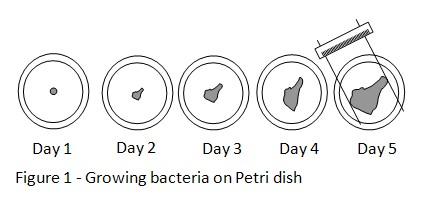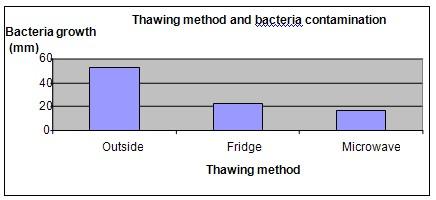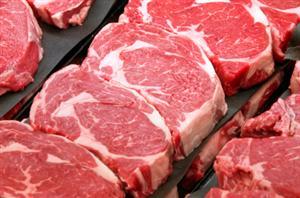Hypothesis
Meat that is thawed in the microwave oven showed the least bacteria contamination.
Overview
Bacteria in the meat
Although most bacteria are harmless to humans, some of them are disease-causing. Pathogens are bacteria that can cause illnesses. Food-borne illnesses occur when pathogens enter our food. Bacteria can be found in any kind of food but they have a tendency to flourish in of protein rich foods like meat, poultry, eggs and dairy products.. The food that we purchase is commonly already contaminated by bacteria, but this problem is easily solved by properly cooking our food.
Meat can be kept in the freezer for long periods of time without getting contaminated. It needs to be thawed before cooking. The most common method of thawing is to leave the meat at room temperature for a few hours . However, the longer the meat is left outside the freezer for thawing, the more bacteria contamination it experiences. Other methods of thawing are by leaving the meat in the refrigerator or by using a microwave.
Scientific Terms
Bacteria, pathogens, food-borne diseases, contamination, microorganism
Conclusion
The hypothesis that the meat thawed in the microwave oven experiences the least bacteria contamination is proven to be true.
Bacteria will contaminate meat very quickly. Leaving meat to thaw at room temperature for too long can cause the food to be unsuitable for consumption. Thawed meat should always be cooked immediately. .
Also consider
The science fair project can be repeated by varying the types of food.
The experiment can also be repeated by using other thawing methods (eg. thawing the meat in a container filled with water, or in a disinfected plastic bag). .
References
The truth about irradiated meat - http://www.mindfully.org/Food/2003/Irradiated-Meat-TruthAug03.htm
Bacteria that cause food borne illness - http://www.infoplease.com/ipa/A0762206.html
What is the best way to thaw frozen meat? - http://www.wisegeek.com/what-is-the-best-way-to-thaw-frozen-meat.htm
Related videos
Hey there! Here are some awesome videos about this science project that we think you'll really like. They're not only super fun, but they'll also help you learn more about the science behind the project. So sit back, relax, and get ready to have some fun!!





